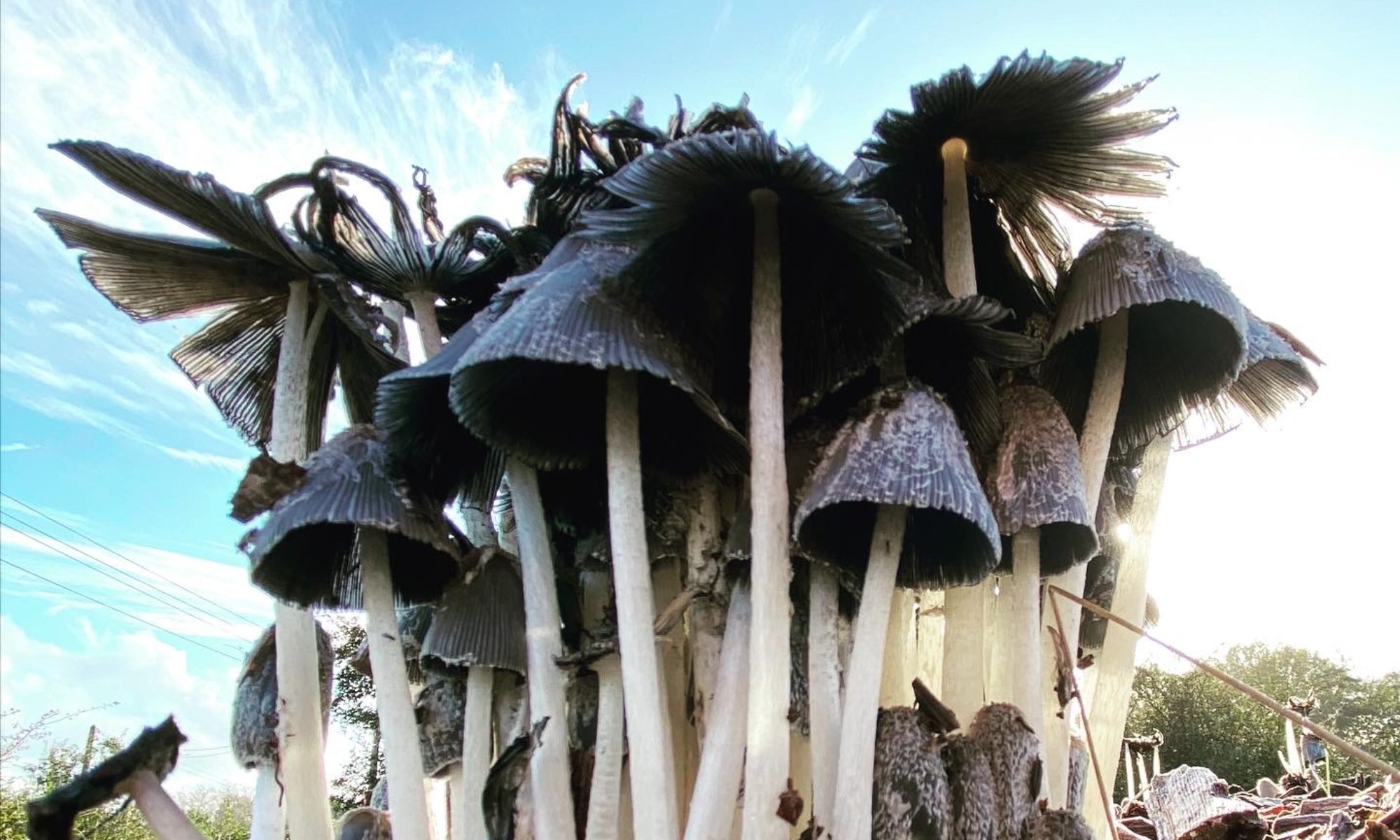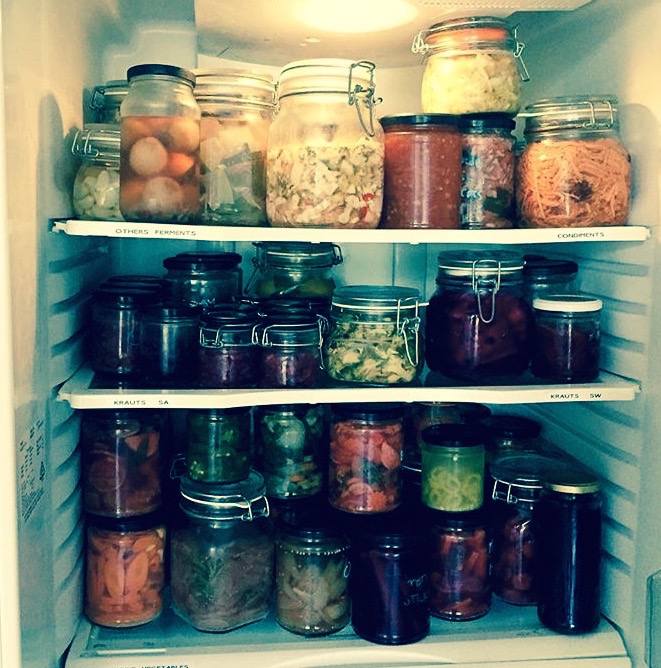A very cultured evening in Bray
Lucy Weir, PhD
Zygonomy is the science behind the art of employing a culture. A culture, in this
sense, is a specific mix of fungal and bacterial strains, often 20 or more species that
exist in symbiosis. The yeasts produce alcohol, and the bacteria consume them,
which means the yeasts can survive, which means the bacteria continue to have a
source of nutrition. These cultures have been a part of our diet since the beginning of
human history, being used to bake bread, preserve food, create drinks, brew beer or
ferment wine. And therefore, of course, they have been essential in the development
of our culture, the way we eat and drink being central to how we relate and
celebrate.
I was provoked into learning more about the process of fermentation after last
Thursday’s wonderful workshop given by Courtney Tyler in Common Ground’s
ground-floor room. The building itself is beautifully atmospheric, an old storehouse,
down a winding lane. There is a sense of hope about the whole place, combined with
a feeling of “make do and mend”, a determination to preserve aspects of Irish
culture, but a welcoming openness to useful elements from other traditions. It
resonates with both old-world charm and a thirst for learning. All in all, it’s a great
place to attend a workshop.
We sat round a scrubbed wooden table and watched as Courtney took us, first,
through the art of sauerkraut making. She had already chopped, into a large
stainless steel bowl (“some people say you shouldn’t use metal- I think stainless steel is
fine, along with glass or ceramic”) a huge red cabbage (she held her hands before
her like a fisherwoman to depict its original size), beetroot, turnip (which surprised
me), raisins she’d made herself from grapes (she told us how she’d come across an
abandoned polytunnel heaving with grapes – about as unlikely a tale as you’re going
to hear, but evidently true!), and salt. How much salt? A lot. She took a large pinch of
salt from a jamjar, large crystals of sea salt with what looked like seaweed flecks
attached, and said, “I think I’ve put about four of these in already”. She added
another two. She peeled a couple of garlic cloves and there was a discussion about
whether or not garlic ferments (it has anti-fungal properties, so tends not to pickle as
readily as cabbage, but she maintains that a little can add good flavour) and turmeric
(“if I’ve brought it”). But no water. sauerkraut, she told us, is “cooked” in its own juice.
She added some ginger, rubbing it against the grater without peeling or cleaning it:
the process itself will kill off harmful bacteria: in fact the skin contains the lactobacilli
the ‘good’ bacteria – this is the beauty of preserving through fermentation.
You could, of course, just stick with cabbage, but half the fun is in experimentation
with flavours, and adding such variety keeps things interesting, just as weaving
anecdotes through the recipes kept us listening. You can also add juniper berries.
This is the essence of culture: to take what’s fresh and, using tradition, extend by
trying something different. Courtney encourages us to play around and taste
frequently.
It takes just two or three days for the vegetables to begin to “sour”, but they’re better
after up to six weeks. You can keep them for a year or more: this is a preservation
technique, after all, but Courtney warns that they lose their crunchiness and she, for
one, finds this less interesting. By massaging the mixture, the brine is released. Use
a wooden masher if you have one to crush the juices out of the vegetables – it’s
astonishing how much liquid they hold – and when that’s done, put everything into a
large preserving jar. It needs to not be airtight – it could explode – but muslin’s useful
as a barrier to keep the culture you want in the jar, and what you don’t want out of it.
Parchment paper also works. Waste nothing. Use the outer leaves of the cabbage to
press the chopped vegetables down and use a weight to keep them from floating to
the surface, above the liquid, where they’ll be exposed to moulds you didn’t invite.
Use the juice from a previous batch to start the next one, and so on. The microbial
content will alter with time, and that will in turn alter the flavour.
Kefir is the most powerful source of probiotics (bacteria and yeast that support the
digestive process) in terms of quantity of flora per weight. The process of keffiring
breaks down the lactose and caisein, particularly in cow’s milk, making it much more
likely that those who are lactose intolerant – one of the attendees fell into this
category- would be able to drink kefir than pasteurized cow’s milk.
Courtney shared her own experience that her allergies disappeared after regularly
drinking kefir, which can be made from either cow’s or goat’s milk. Courtney has two
goats herself and she enthused on their affectionate natures (“they’re just like dogs!
They’ve got such unique personalities!”. She grazes them with a couple of horses in
a field behind her house, and the uses two shipping containers, one for housing
them, one for milking and storage (the effort of milking is borne out in the taut
muscles of her forearms which are as muscular as a sailor’s. She also squats while
milking which, she assures us, is excellent for her glutes!).
Between talking, grating, mashing and gesticulating, Courtney passed round bottles
of kefir, kombucha, ginger, and fruit soda. We poured a small amount to taste of
each in turn into our emptied cups (we’d been given little cups of Chai to begin, with
the sort of elegance usually reserved for a Japanese Zen tea ceremony). We
discussed the difference between intolerance and allergy, and the importance of
starting slowly. During our discussion, a clearer picture of Courtney’s lifestyle
emerged: her house is evidently a veritable fermentation factory, armies of bottles
marshalled on every available surface not already occupied by the rows of jars
squatting or stacked on shelves, eliciting a single, eloquent, “Seriously, Courtney?”
from her partner.
We discussed the need to develop the hoarder’s habit when it comes to suitable
containers. Grolsch bottles with the rubber gasket are good: you’ll hear a buzzing,
hissing sound as the the gasket lets excess gas escape. Sugar, lots of sugar, is an
essential ingredient to feed the culture. Images of slave ships struggling to feed the
ravenous but increasingly refined tastes of northern Europe and the Americas spring
to mind. Fair trade is best!
As Courtney tackled opening a particularly lively grape soda, the discussion moved
to safety tactics for dealing with potentially explosive bottles (exploding bottles are an
occupational hazard for the inexperienced fermenter). Put the suspect bottle in a
large jug or bowl, and open it under the umbrella of another jug (you need fierce
dexterity for this), preferably not glass. And no, the fizz doesn’t fill you up with wind:
there’s even evidence that kefir reduces flatulence in those who are lactose
intolerant.
While we tasted the various concoctions, all good, fresh, interesting (alternately
sharp, sour, sparkly, sweet and fruity on the tongue), Courtney began to describe
making the next concoction, “ginger bug”. Start small, with non-chlorinated water,
one teaspoon of sugar, one of ginger, and stirring the mix as often as possible for the
next couple of days. Watch. After three or four days, carbonation builds up, you’ll see
little bubbles appearing at the edges. When it’s “lively”, it’s ready to use as a starter
for your homemade sodas: just add it to a sweetened juice or syrup. Cover with a
muslin cloth (or, if you’re really strapped, a clean pillowcase, cut up). Beneficial
yeasts from the air can then get through.
When making kombucha, you need tea and sugar and a starter. All the while,
Courtney pounded with her “sauerkraut stamper”, the only object (rejecting her
alternative inheritance of an enormous collection of dolls) from her grand-aunt in
Michigan who had herself inherited the stamper from the first immigrant ancestor of
the family who had brought it from Germany in the eighteenth century. It was dark
wood, stained purple with all the pounding of cabbage, but only marginally rounded
at the edges.
Pickles were discussed. Cider apple vinegar. The air sharpened with memories.
Water kefir. Something similar was made, one of the participants remarked, by her
grandparents. She took some to her parents to taste and her father closed his eyes
and said, “You know, you’ve brought me back fifty years!” In barrels in the corners of
kitchens all over Scotland, the north of England and the northern half of the island of
Ireland, people tended their “ale plant”. Some fed it molasses. It tasted of ginger, and
sparkled slightly.
As she pounded, Courtney talked briefly about other things that could or could not
successfully be incorporated into sauerkraut. Broccoli and kale can give off a
pungent, unpleasant odour, unless used sparingly. Nettles do. Cucumbers need lots
of salt. Caraway seeds work in white cabbage sauerkraut. Eastern European and
French traditions were discussed. including different uses for fennel, and fennel
seeds, and how every society has traditional remedies to increase the production of
breastmilk…
The conversation flowed as Courtney moved the discussion back and forth between
cultures, coming back to the sauerkraut, pouring it into a huge jar, tamping it down
and covering it with a cabbage leaf, at least two inches of liquid covering the
vegetables. She talked a little more about developing the “ginger bug”, tending each
topic like the cultures themselves – a moment of attention here, a tweak there.
Culture, like conversation, needs nurturing until it gets active.
Finally, fruit soda, a brew made by boiling up a large pot of water with fruit – Courtney
had redcurrants and grapes (how much? Again, she held her hands as though
holding a small rugby ball to indicate the sort of quantity of fruit required), and sugar
(two cups, but like all Courtney’s advice, this was tempered with the suggestion that
we taste as we go to see what works for us). Mash the fruit, squeeze everything
through a muslin cloth (or the nearest equivalent). Wait for it to cool to body
temperature or about 80 degrees F which is when the starter is happiest, and stir it
all together in a demijohn or preserving vessel. Primary fermentation is when you
add your biotic to the sweet liquid. To add fizz – that’s secondary fermentation – store
it in an airtight bottle and if needed, add another spoonful or two of sugar.
There were sixteen of us there, from France, Eastern Europe, various parts of
Ireland, England, Scotland, and the US. She held us rapt. Play, she said. See what
works. Don’t worry about quantity. Respect tradition and learn as much as you can
but the main thing is experimentation. The art of fermentation is a willingness to fail,
and try again, and fail better. Like the evolution of societies themselves, the very
roots of our cultural history were in symbiosis with bacteria and yeast. Bread and
beer and wine are famously revered. Reviving an interest in their lesser known
cousins – kefir, kombucha, sauerkraut, natural soda – marks a welcome and
important revival.
Courtney’s website is www.hipsandhaws.com
Another useful website is the American website www.culturesforhealth.com. It has
endless recipes and instructions for all types of cultured foods. Particularly helpful
are the free ebooks that you can download on signing up to their mailing list.


